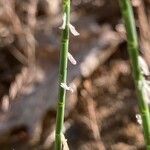Small annual tufts 10-30-(45) cm, often growing closely together to form large patches, plants usually rigidly erect but sometimes with shoots appressed to ground. Leaf-sheath submembranous, glabrous, straw-coloured, striate. Ligule 0.2-0.7 mm, membranous, glabrous, truncate, erose, projecting slightly upwards on either edge. Leaf-blade 2.5-9-(11.5) cm × 1.2-1.7 mm, flat, or inrolled and c. 0.5 mm diam., abaxially glabrous, adaxially ribbed, ribs minutely scabrid. Culm 5-30 cm, sometimes purplish, usually branched near base, internodes glabrous. Inflorescence a single simple spike, breaking up at maturity by disarticulation of rachis below each spikelet. Spikes 6.5-15 cm, cylindric, rather thick, straight or slightly curved, light green; rachis internodes ≤ spikelets, hollowed on one side. Spikelets 5-7.5 cm, 1-flowered, sessile, solitary, edgewise to rachis, alternating on opposite sides of rachis, ± sunk in cavities within it; each floret ± concealed by one glume, uppermost floret with 2 glumes. Glumes 9-nerved, very hard, thick and rigid, oblong-subulate, acute, outer nerves slightly scabrid near apex; glume concealing floret at first, but later sometimes recurved and projecting stiffly at 45 from the rachis. Lemma 4.5-6.2 mm, with back appressed to rachis, membranous, finely 3-nerved with lateral nerves indistinct, lanceolate, acute, glabrous. Palea ≈ lemma, 4-5.5 mm, hyaline, glabrous, keels 2, indistinct. Lodicules 2, glabrous, 1-1.5 mm. Stamens 3; anthers 1.5-2.5 mm. Caryopsis c. 3-3.5 × 0.8-1.1 mm, longitudinally grooved; embryo small; hilum short, linear to oblong.
More
Erect annual, 50-350 mm high. Leaf blade up to 7.0 x 2.5 mm; ligule an unfringed membrane. Inflorescence a cylindrical spike, solitary; spikelets edgeways on and sunk in rachis. Spikelet 5-8 mm long, dorsiventrally compressed, awnless; lower glume suppressed except in terminal spikelets which has both glumes present. Floret 1; lemma glabrous, 3-nerved; anther 1.0-1.5 mm long. Flowering time Nov., Dec.
Culms 4–48 cm high. Leaves: ligule 0.2–0.6 mm long; blade subulate, 3–16 cm long, 1.5–2.6 mm wide, ±acuminate. Spikes 1.1–13.5 cm long. Bisexual spikelets 4.3–7.2 mm long; upper glume 4.3–7.2 mm long, 1–1.9 mm wide, with hyaline margin; basal lemma dorsally compressed, 4.3–5.5 mm long, with intercostal regions minutely papillose. Anthers 1.6–2.6 mm long.
Erect annual 50-350 mm high. Leaf blade 7 x to 2.5 mm. Inflorescence a cylindrical, solitary spike; spikelets sunk in the rachis. Spikelet 5-8 mm long; glume 1, lower glume suppressed except in terminal spikelets, which has both glumes present; floret 1; anthers 1.0-1.5 mm long.
Annual to 30 cm. Leaves linear. Spikelets in a simple spike, green, 5-8 mm long, alternate and embedded in an articulated rachis, awnless.

